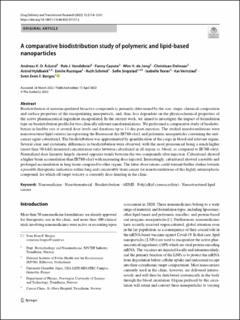| dc.contributor.author | Åslund, Andreas | |
| dc.contributor.author | Vandebriel, Rob J. | |
| dc.contributor.author | Caputo, Fanny | |
| dc.contributor.author | de Jong, Wim H. | |
| dc.contributor.author | Delmaar, Christiaan | |
| dc.contributor.author | Hyldbakk, Astrid | |
| dc.contributor.author | Rustique, Emilie | |
| dc.contributor.author | Schmid, Ruth Baumberger | |
| dc.contributor.author | Snipstad, Sofie | |
| dc.contributor.author | Texier, Isabelle | |
| dc.contributor.author | Vernstad, Kai | |
| dc.contributor.author | Borgos, Sven Even F. | |
| dc.date.accessioned | 2023-01-24T08:31:20Z | |
| dc.date.available | 2023-01-24T08:31:20Z | |
| dc.date.created | 2022-04-29T13:22:23Z | |
| dc.date.issued | 2022 | |
| dc.identifier.citation | Drug Delivery and Translational Research. 2022, 12 2114-2131. | en_US |
| dc.identifier.issn | 2190-393X | |
| dc.identifier.uri | https://hdl.handle.net/11250/3045670 | |
| dc.description.abstract | Biodistribution of nanoencapsulated bioactive compounds is primarily determined by the size, shape, chemical composition and surface properties of the encapsulating nanoparticle, and, thus, less dependent on the physicochemical properties of the active pharmaceutical ingredient encapsulated. In the current work, we aimed to investigate the impact of formulation type on biodistribution profile for two clinically relevant nanoformulations. We performed a comparative study of biodistribution in healthy rats at several dose levels and durations up to 14-day post-injection. The studied nanoformulations were nanostructured lipid carriers incorporating the fluorescent dye IR780-oleyl, and polymeric nanoparticles containing the anticancer agent cabazitaxel. The biodistribution was approximated by quantification of the cargo in blood and relevant organs. Several clear and systematic differences in biodistribution were observed, with the most pronounced being a much higher (more than 50-fold) measured concentration ratio between cabazitaxel in all organs vs. blood, as compared to IR780-oleyl. Normalized dose linearity largely showed opposite trends between the two compounds after injection. Cabazitaxel showed a higher brain accumulation than IR780-oleyl with increasing dose injected. Interestingly, cabazitaxel showed a notable and prolonged accumulation in lung tissue compared to other organs. The latter observations could warrant further studies towards a possible therapeutic indication within lung and conceivably brain cancer for nanoformulations of this highly antineoplastic compound, for which off-target toxicity is currently dose-limiting in the clinic. | en_US |
| dc.language.iso | eng | en_US |
| dc.publisher | Springer | en_US |
| dc.rights | Navngivelse 4.0 Internasjonal | * |
| dc.rights.uri | http://creativecommons.org/licenses/by/4.0/deed.no | * |
| dc.subject | Nanostructured lipid carrier | en_US |
| dc.subject | Poly(alkyl cyanoacrylate) | en_US |
| dc.subject | ADME | en_US |
| dc.subject | Biodistribution | en_US |
| dc.subject | Nanobiomaterial | en_US |
| dc.subject | Nanomedicine | en_US |
| dc.title | A comparative biodistribution study of polymeric and lipid-based nanoparticles | en_US |
| dc.title.alternative | A comparative biodistribution study of polymeric and lipid-based nanoparticles | en_US |
| dc.type | Peer reviewed | en_US |
| dc.type | Journal article | en_US |
| dc.description.version | publishedVersion | en_US |
| dc.rights.holder | © The Author(s) 2022 | en_US |
| dc.source.pagenumber | 2114-2131 | en_US |
| dc.source.volume | 12 | en_US |
| dc.source.journal | Drug Delivery and Translational Research | en_US |
| dc.identifier.doi | 10.1007/s13346-022-01157-y | |
| dc.identifier.cristin | 2020147 | |
| cristin.ispublished | true | |
| cristin.fulltext | original | |
| cristin.qualitycode | 1 | |

